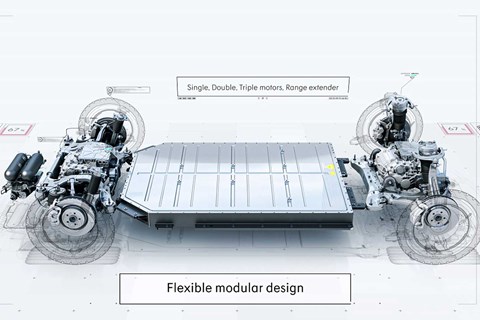Lotus is going truly global, planning exponential growth in volumes fuelled by manufacturing, design and engineering capabilities outside the UK.
Sports cars such as the Evija will remain the heart of the domestic operation, vows new Lotus Cars boss Matt Windle, but majority shareholders Geely will provide the funds and industrial footprint to fast-track the brand’s growth overseas.

Loss-making Lotus has to expand its range to become a viable company: in 2020 it manufactured 1378 cars (not far off the typical output of the pre-Covid years), but that’s less than one car for each of the company’s 1560 UK employees.
‘It’s important that people realise that the business model of selling a small number of sports cars just doesn’t work in the long run,’ says Windle. ‘We now have the opportunity to go into new markets, new segments, new technologies, which will give us the revenue that allows us to keep doing cars that people love out of Hethel in the UK.’
The first step: assembling cars in China
As Car revealed yesterday, Lotus is developing its own vehicle architectures to underpin its new model expansion. The company’s final combustion engine sports car platform (underpinning 2022’s Emira, initially known as Type 131) will make way for a lightweight EV sports car architecture, but it’s the ‘lifestyle architecture’ that will underpin game-changing growth.
First images and key details of new Lotus Emira
Lifestyle architecture vehicles are set for assembly in China, at Geely’s new factory in Wuhan. The site has a planned capacity of 150,000 vehicles, but don’t think all that volume is for Lotus: it will be used by multiple brands within the booming group (portfolio below), which sold 2.1 million vehicles last year.

One likely inhabitant of the Wuhan factory is Geely’s new premium EV division, Zeekr. It will launch its first electric car this year on the group’s Sustainable Experience Architecture (below), deploying its own battery tech, management systems and e-motors. Lotus can tap into these group technologies, because all future cars after Type 131 will be pure electric.

How big will Lotus get?
‘The potential is huge,’ says Matt Windle. ‘There's room in segments for us to go into, we’re aiming to take market share from some of our nearest competitors. Lotus will become a global company with aspirations for volumes to support that ambition.’
With only a single shift, Hethel’s capacity is limited to 5000 units annually. Within the Vision80 business plan out to 2028, there’s surely the opportunity for volumes to grow to ten times that and beyond – assuming China embraces four-door Lotus cars.
The textbook example of SUV-fuelled expansion is Porsche: it transformed from a niche sports car company to a record 280,000 units, powered by the Cayenne and subsequently the Macan. That growth took the best part of two decades though.
‘If we can get to Porsche [levels one day], I'd love that. But it’s not about being Porsche, we want to do it in our own way. With ingenuity and by being nimble, and that’s one of the things I have to balance when building an organisation to grow.’
How else is Lotus benefiting from Geely ownership?
Geely is committed to Lotus remaining a sports car company: Windle credits the holding group chairman Eric Li with being the strongest advocate of making the Evija pure electric hypercar the first car of its new era.

‘Look at Geely’s track record with Volvo,’ says Windle, explaining its approach which is engaged but far from autocratic. ‘I like this analogy: Geely pushes out the boat, they help [set the course] but they don’t jump on the boat. This is still Lotus.’
Lotus has full access to the Geely supplier base – ‘if we hit a technical problem, say sourcing a steering rack, we phone up our colleagues, have a look at what they’ve got and if it works do a deal over it.’
On the new sports car, Emira, ‘not a lot’ is shared with other group models: some switches, column stalks, some of the base electric architecture, ‘high-investment, low impact stuff,’ says Windle. Power comes from the Toyota V6 known from the Exige and Evora, and a 'high-output, lower-capacity engine, where we're partnering with a very famous engine manufacturer'.
Aggresive price pegs Type 131 closest to Cayman
And tapping into the Chinese parent’s supplier base has helped drive down costs. So the Type 131 will be priced between the Porsche 911 and Cayman, but ‘much closer to Cayman’. Windle adds: 'There have been a lot of rumours that this car is hybrid, and it's an Esprit replacement, but it's neither of those.'
Two product planning decisions that also fed into that keen price, and which will be vital to help the new sports car be the first building block in Lotus’s growth mission.
Lotus boss: 'forget hybrid, we're going straight to electric'